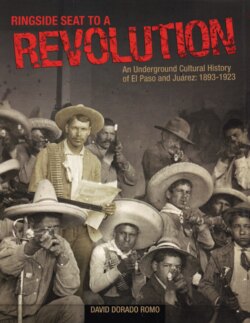Читать книгу Ringside Seat to a Revolution - David Dorado Romo - Страница 17
На сайте Литреса книга снята с продажи.
Оглавление11
This book also deals with the viewpoint of the
binational community of El Paso and Juárez. These
two cities probably did more to spark the Mexican
Revolution than any other city in either Mexico or the
United States. Yet their stories are still untold. They
have been considered marginal and unimportant by
the cultural centers in both Mexico and the United
States. This book is about a historical perspective that
has been driven underground, buried underneath
racist mythologies found in those ubiquitous books
about the so-called Wild West. Incredibly enough,
even in this day and age, you won’t find much other
than books about the Old West in the local history
section at most El Paso bookstores. In those best-sell-
ing versions of history, Anglo gunslingers and Texas
Rangers get all the good lines (just like in the movies)
while border Mexicans just play the cameo roles—
mostly innocent bystanders that get shot in the stom-
ach during the gunfights.1 Although there are always
two sides to every history, it’s usually only one side
that gets told in these accounts.
IN THE REST of the United States, the historical
narratives that reach the mainstream have become
more inclusive. But you get a sense that the really
good stories are still being told in black and white, in
other words, about White America and Black
America. Take many of the history documentaries
shown on public television these days. Whether
they’re about jazz, or the Civil War, or Jack Johnson—
the stories they tell are about African Americans and
European Americans and they are inextricably inter-
twined. They go to the very heart of the mainstream
American narrative.
It’s understandable why filmmakers and histori-
ans choose a dichromatic approach to the past. The
stark contrast between Black and White makes both
for great photography and fascinating history.
But it’s not the whole picture.
Most educated Americans have heard of the
Harlem Renaissance. But how many of them are
aware of the cultural renaissance El Paso experienced
during the Mexican Revolution?
The story of Rosa Parks refusing to move to the
colored section of the bus has become a central
drama of the American experience, and rightly so. But
the story of 17-year-old Carmelita Torres, who in 1917
refused to get off the El Paso-Juárez trolley to be
deloused, bathed in kerosene and have her head
shaved by U.S. immigration authorities, has never
been told. Why is her experience also not part of the
American consciousness?
Maybe because the history of the border has
never been considered a truly American history.
Some might even need to be reminded that El Paso
is, in fact, a city in the United States. I’m willing to bet
that you didn’t find this book in the “American
History” section of the library or bookstore, although
most of this book is about an American city.
Fronterizos, people who live on the border, are
unclassifiable hybrids. They are not exactly immi-
grants. Immigrants don’t cross back and forth as
much. Border crossers are a people on the margin.
Not real Americans. Nor real Mexicans for that matter.
But I think the trend is changing. At least I hope
so. Their story, or should I say, our story is increas-
ingly becoming a part of the mainstream. Little by lit-
tle American history begins to take on hues of bronze
and brown—sepia tones—as well.
RINGSIDE SEAT TO A REVOLUTION deals
not so much with history as it does with microhisto-
ry.2 A surprisingly large number of the events related
to the Mexican Revolution took place within a five-
square-mile area between downtown El Paso and the
Juárez customhouse.
Microhistory at its best is more about small ges-
tures and unexpected details than grand explanations.
During the course of my research at the archive cen-
ter of the Smithsonian Museum of American History,
I looked through a box full of the personal papers of
Victor L. Ochoa—the first El Paso Mexican American
to launch a rebellion from the city against the govern-
ment of Porfirio Díaz in 1893. (This collection was
donated to the Smithsonian by his family members a
few years ago.) Ochoa was the editor of El Hispano-
Americano in 1892. Later, he was also the director of
an El Paso intelligence agency for one of the rebel
factions that was against Pancho Villa. I expected to
find mostly political articles he’d written or other
newspaper clippings that would help me understand
the motivation for Ochoa’s revolutionary activities.
To my surprise, I found instead that the box was
mostly filled with patents in various languages for
several of his inventions—a magnetic brake for street
cars, a fountain pen, a holder for fountain pens, a
1
“He [John Wesley Hardin] punctured two Mexicans in 1871,” wrote C. L. Sonnichsen in Pass of the North: Four Centuries on the
Rio Grande, Vol. I (Texas Western Press: University of Texas at El Paso, 1968), p. 324. It is the only reference to Mexicans
involved in a gun fight included in his classic 467-page history of El Paso.
2
See Invitación a la Microhistoria by Luis González y González.
